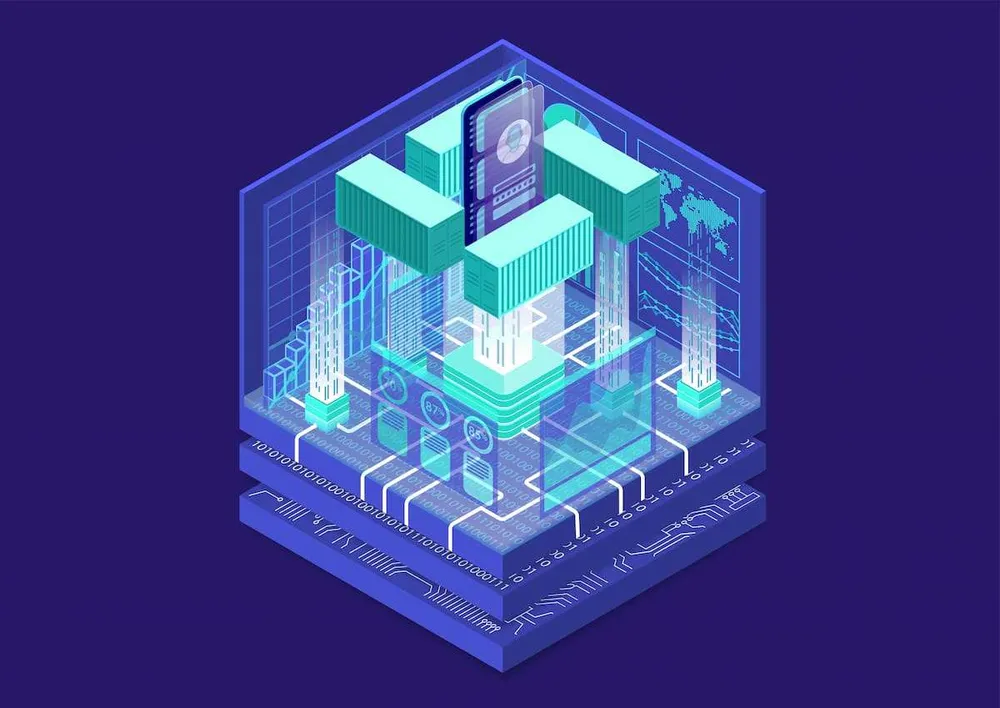Containerization: Advantages and Use Cases

Containerization is a software development method involving putting apps in an isolated environment. As a specific sub-type of virtualization, it is extensively utilized by the creators of microservices and cloud-based solutions. The practice allows developers to use the available resources with maximum returns, speed up the deployment of digital products, and scale up processes with ease. As self-contained spaces have the same host operating system (OS), professionals can employ them to ensure the consistent performance of the apps in a range of environments.
Due to the widespread adoption of container technology, users now can access dedicated platforms fitted with tools for working with such units. It enables specialists to develop and test containerized software independently without considering the infrastructure. In this guide, we will explain the term in detail and outline the key benefits of the method.
What is Containerization?
Containerization is a sub-type of virtualization that allows apps to be deployed in isolated environments utilizing the same OS. What makes the method stand out is its extreme convenience, as it facilitates running applications in pre-designed portable spaces fitted with dependencies.
As containers function almost independently of the host OS, they share some characteristics with virtual machines (VM). However, once an app has been put into a container, it can run within a VM and in the cloud. The strategy allows developers to save a lot of time eliminating the need to install a separate OS for each app.
This result-yielding approach facilitates testing microservices found at the core of every app. Containers get executed in any environment due to their extreme portability and resource efficiency. As they are so lightweight, they are a more feasible option than VMs when it comes to running cloud-native apps.
The architecture of such isolated units comprises four layers:
- Infrastructure: It includes computers and servers.
- Host OS: The layer creates a suitable environment for a container and may comprise a physical or virtual machine.
- Runtime engine: Serving as an execution environment for container images, it runs in the host OS.
- Apps: The top layer consists of programs deployed in containers.
The extreme security and high speed of this deployment method make it more convenient to use than traditional approaches. Before it was widely adopted, most professionals wrote code in a specific environment knowing all too well that they would have to fix countless bugs when running an app on a different infrastructure. Such issues were typical for situations when developers had to switch between different OS or utilize a VM. However, the new method streamlines the process and allows specialists to bundle everything a code needs to be deployed independently from the host OS.

We are confident that we have what it takes to help you get your platform from the idea throughout design and development phases, all the way to successful deployment in a production environment!
Benefits of Containerization
In 2013, when the Docker software was released, developers got an opportunity to speed up the process of building and deploying apps using standardized units. Running and testing containerized applications using web-based platforms allows coders to deploy them smoothly. Nowadays, 74% of companies in the industry utilize containers via a platform as a service (PaaS).
There are multiple upsides to employing containers. As they share an OS’s kernel and are known for more limited capacity than VMs, they can be deployed in no time. Utilizing the same computing capacity, a multitude of units functions as one VM. The approach yields the following benefits:
- Extensive code accessibility;
- Low licensing expenses;
- Reduced server costs;
- Quick start-up time;
- Streamlined management;
- Top-grade security;
- Portability;
- Maximum server efficiency.
Developers have convenient tools that facilitate running apps on-premises, in the cloud, and multi-cloud environments.
When comparing containerization vs virtualization, it is crucial to highlight the fact that both methods facilitate running different types of apps in a single environment. Nevertheless, the former uses the available resources dexterously, as its base units are easy-to-execute packages comprising code with its dependencies.
Containers do not include a copy of the OS, which makes such spaces more efficient than VMs. Instead, they install its runtime engine on the host system’s OS.
Virtualization requires using a software layer on a physical PC or server, which enables multiple OS and apps to run at the same time sharing resources. Thus, it becomes possible to run two different OS or multiple versions of a specific OS on the same server. Using VMs running on the same computer permits companies to save resources and reduce operational expenses.

Why Is Containerization Important?
Recently, the number of enterprises employing microservice environments has increased to 90%. The method is invaluable for DevOps engineers who need to produce custom services without relying on dedicated servers.
Containerization technologies enable professionals to run apps in a range of environments without leveraging a lot of resources. This agile approach facilitates increasing operational efficiency by performing testing in a controlled sandbox.
The significance of containerization lies in its ability to enhance all the stages of a digital product’s lifecycle. However, deployment units have many other uses besides being instrumental in creating cloud native apps. Container orchestration at scale is employed by developers who need to automate the process of managing independent units and deploying digital solutions without considering the baseline infrastructure.
Below, we have outlined the main use cases of containerization to emphasize the pivotal role it plays in scaling up businesses.
- Creating consistent environments: Companies of all sizes face difficulties when trying to build and deploy cross-platform products capable of running smoothly in various OS. A small problem may result in a host of unforeseen consequences. Thanks to containers, coders run an app in the same virtual sandbox they created and tested it. As it is fully controlled, it facilitates discovering possible issues and fixing vulnerabilities.
- Maintaining top-level security: By keeping the infrastructure and the development environment isolated, teams avoid making them dependent and mitigate the risk of possible conflicts. This step facilitates running various projects on the same server simultaneously. Even if one of the separate units becomes affected by hackers, others won’t be impacted.
- Optimizing production: Using containers makes it possible to decrease the time to market, as developers can build and release new tools without wasting a lot of time. In addition, they can quickly revert updates when something goes wrong and restore a previous version. Coders no longer need to wait until a VM boots up the OS, as containers can be deployed without delays.
- Building complex architecture: Such platforms as Docker enable coders to focus on writing mistake-free code. Its tools are accompanied by comprehensive descriptions, which capacitates users to understand how to make the most out of the features and grasp the connection between various runtime components.
- Migrating to the cloud: Many small and medium-sized businesses (SMEs) depend on on-premise solutions. It might be challenging to switch to cloud-native solutions and become agile. However, the usage of deployment units makes it possible to run processes on-premise efficiently. Utilizing containers as a service (CaaS), businesses can access computing tools based in the cloud that facilitate the management and deployment of containerized apps. The adoption of this technology facilitates migration to cloud platforms, as microservice environments function in the same way regardless of where a company hosts them.
- Reducing downtime: Avoiding situations when a client cannot access services is crucial to ensure the stable development of a business. Containerization fosters continuous operations and lets developers place units on different machines, store runtime environments on-premises, or transfer them to the cloud. This approach facilitates building stable systems and managing internal processes efficiently. Such solutions as Docker streamline monitoring performance using specific metrics.
- Building continuous integration and continuous delivery (CI/CD) pipelines: Such solutions automate all the steps of software development, from editing code to deploying the most recent versions. As each stage is executed consequently, deployed code is mistake-free. Small units containing apps and dependencies are easier to run and manage. CI/CD streamlines process automation.
- Integrating legacy systems: The containerization of such applications makes it possible to deploy them together with innovative solutions and access specific frameworks, tools, and databases. It enables large and cumbersome systems to evolve and improve.
Besides streamlining application modernization, this method lets SMEs and large enterprises ensure their products run seamlessly in popular OS. The usage of containers allows for enhancing security, optimizing the rollback process, and minimizing the number of post-deployment bugs. Even though many corporations are slow to upgrade legacy systems, they have started to recognize that containers are the key to full digital transformation.
Examples of Containerization
SMEs and large companies failing to adopt new software development methods may discover that competitors have already employed them to increase the efficiency of processes. This is why it becomes crucial to recognize the transforming power of technology and successfully use it to improve products and services. There are several use cases of isolated containers:
- Microservices: When isolated units operate together, it allows developers to build a complex architecture. Professionals working on Internet of Things (IoT) solutions leverage containerization to build programs connecting personal computers, GPS modules, and other devices.
- Databases: An increasing number of firms utilize hybrid pipelines instead of storing data on-premise, as these container databases run smoothly on multiple cloud platforms and enable businesses to scale up operations and process a high number of tasks during peak times adeptly.
- Web servers: In a few clicks, a specialist can run a server within a deployment unit, thus saving valuable resources.
- Sandboxes within VM: Running software and dependencies within VMs boosts security and allows firms to make the most out of hardware.
Building cloud-native apps and stateless products is easier than ever if a company utilizes self-managed containers. Besides, the technology streamlines analyzing virtual objects and running complex data systems in clusters.
Final Thoughts
Recognizing the transformative potential of new technology is the first step toward embracing an agile approach to software development, optimizing resources, and streamlining internal processes to get a cutting edge. At Global Cloud Team, we have specialists with years of experience in building cloud apps. Whether you want to create a new product from scratch, migrate your legacy system to the cloud, or learn how to make the most of virtualized platforms, we will leverage automation tools to help you manage valuable resources adeptly.
We strictly follow modern security guidelines and ensure full protection of user data. Our team knows how to employ containerization to release, scale, and improve apps more quickly. You can optimize production cycles and expand your outreach by accelerating the development process. Contact our specialists and discover how to deploy your isolated environments across different OS!
Top Articles
A Deep Dive into Agentic Workflows: How They Work
I am here to help you!
Explore the possibility to hire a dedicated R&D team that helps your company to scale product development.






